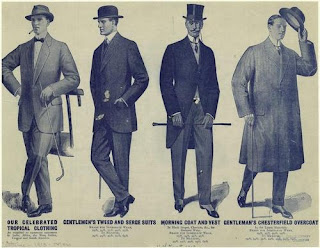Overall, I am
pleased with the tailoring work I have done and think it is of a good standard.
However, I am disappointed that I have not been able to learn more through this
project and feel that I still lack tailoring skills that I will need in the future.
I understand that this is a result of my work placement, which has reduced the
time I have had to complete my tailoring work, but I have gained valuable
experience by completing this.
Tailoring is an
area that interests me greatly, and I have enjoyed researching further into it.
Initially, I think I focused too much on general research into tailoring when I
should have perhaps looked more at techniques I would be using, together with
fabrics. Once I realised this, I did change the direction of my research and I
think I have learnt much from doing this. On reflection I
could have perhaps gone into greater depth with my research, particularly
concerning fabrics, although time constraints meant that construction of the
jacket became my main focus. During construction, however, I think my research
skills were of sufficient quality to enable me to find a solution to my pocket
flap problem independently.
I enjoyed
drafting the patterns for this project and have increased my knowledge of this
process. I think I am developing an eye as to what looks right in relation to
patterns and their alteration. However, I think that in general, too much time
was spent on drafting the patterns, particularly when considering the time I
then had left to construct the jacket. Nevertheless, I appreciated that this would
have been difficult to change, as there was no time before the Easter break to
get fabric, which was needed for the next stage.
I am happy with
my fabric choice and think it fits the period well; in addition the herringbone
stripe adds a challenging dimension. This did provide some problems,
particularly in relation to the pockets, as these had to be matched with regard
to the stripes and because of the additional challenge of a flap, they took
much longer than I had anticipated. It perhaps may have been easier, given my
time constraints, to have picked a plain fabric, but it was difficult to find a
suitable fabric I liked and I did not see any plain fabric that I thought would
work as well as the herringbone.
I am pleased
nevertheless, with the pockets and the way they match. The flap was an extra
challenge but now I know more about how to sew these and the general shape of
them. The inside jetted pocket’s left side is slightly too slanted, probably as
a result of sewing past the upright and so I will be more careful of this in the
future.
I am glad I had
time to learn how to do trouser side entry pockets and a fly, as these are extremely
useful skills to know. I think my pockets are more successful than the fly but
I found them easier and simpler to construct. I definitely need to practice
doing button holes, as I am not happy with the ones that I have done. Similarly, I found the last step of
the fly particularly difficult, as the button placket did not reach as far over
as I had expected. I am also concerned about the raw edges of the fly, in
particular, whether these will be on show once the trousers are finished.
With regards to
my work placement, I have enjoyed my time there and although it has meant I
have not been able to learn as much tailoring, as I would have liked to during
the project, the placement has given me a beneficial insight into the
professional environment. It has been exciting working on the Olympics’
costumes, as this is probably a once in a life time opportunity. Although I
have gained few new technical skills on my placement, I have gained valuable practical
experience.
This tproject has
allowed me to gain construction skills and experience, which I have enjoyed learning,
not least because of the challenges they have presented me with and the need
for me to use my problem solving skills. Tailoring is an area of work that I think I would like to
continue with in my third year and so I am extremely keen to complete my jacket
and trousers to enable me to progress further with my development of skills in
this area.

















































